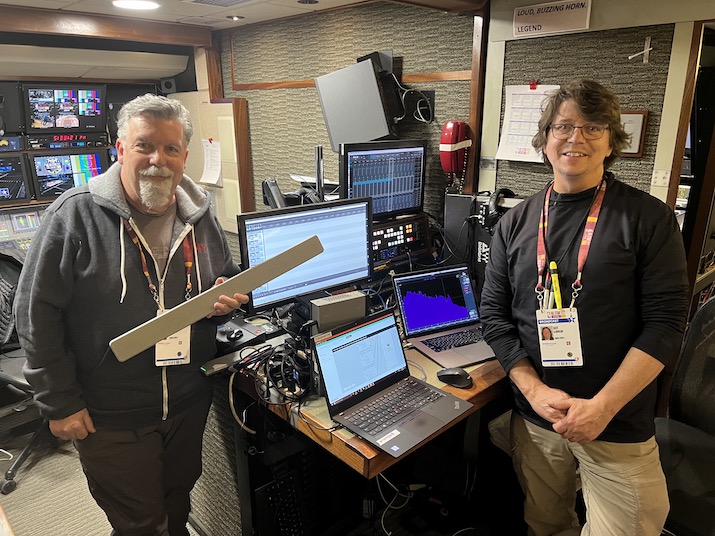Live From NBA All-Star 2022: Innovations Complement Custom Direct PA System
Contact mics, steerable-line-array mics, robust live system promise clean on-air sound
Story Highlights
The NBA All-Star Weekend (Feb. 18-20 in Cleveland) is pretty much 72 hours of nonstop B-ball action. On Friday, the Ruffles NBA All-Star Celebrity Game will be played at the NBA Cavaliers’ Rocket Mortgage Field House, which hosts the entire weekend’s activities, and broadcast on ESPN. On the calendar for Saturday — or State Farm All-Star Saturday Night — are the Taco Bell Skills Challenge, the MTN Dew 3-Point Contest, and the AT&T Slam Dunk, all also on TNT. On Sunday, the Clorox Rising Stars event will be shown on TNT, which will also air the All-Star Game itself.
But the audio will come from one source: the seemingly infinitely innovative brain of Dave Grundtvig, who is serving as TNT’s audio supervisor for the weekend.
He’ll be working from NEP EN1 mobile unit for the Friday and Sunday shows, including the marquee match. Grundtvig says much of the weekend’s audio will be “conventional,” but that’s a term he has helped redefine during the pandemic. He engineered the NBA’s famous Orlando “bubble,” for which he designed and hand-built an array of 32 custom contact microphones placed beneath each of the three courts at the venue there.
Although he cannot wire the Cavs’ court floor, Grundtvig will deploy several contact mics in key locations, such as the backboard glass and on the support poles under the baskets. He will be working with audio guarantee Dave Bjornson; RF supervisor Victor Victoria; Pat Thornton, who will be handling A1 duties for the State Farm All-Star Saturday Night events (from NEP Supershooter 24); and his son, A2 Nicholas Grundtvig.

Aboard NEP EN1 with Dave Bjornson (right), Dave Grundtvig holds one of the Shure MXA710 steerable linear-array microphones.
Another element that may one day become part of a “conventional” microphone complement is the implementation of Shure’s MXA710 steerable linear array. Developed for corporate-boardroom–type applications, the array is a series of steerable transducers guided via Shure’s proprietary IntelliMix DSP and Autofocus technology.
“Using this, we can create steerable lobes and point them in different directions as needed, remotely,” explains Grundtvig, who has also experimented with this type of array for baseball and NBA Summer League. “We can do gating, noise reduction, and automix all internally within the device using its DSP. This is a whole new category of microphone for broadcast applications. We’re in uncharted territory with this.”
Viewers can expect to hear as many as a dozen NBA players wired for sound, along with two coaches and two referees — all wearing Q5X PlayerMic transmitters. Grundtvig says some of that player audio may be live, depending on NBA approvals.
‘A Beast of a System’
Live sound for NBA All-Star Weekend will get the full treatment. A separate house PA system has been installed, comprising 114 boxes of JBL VTX 2025 PA systems. Mark Dittmar, VP, Firehouse Productions — which also deployed a Riedel intercom system with 600+ endpoints, more than 100 of which are wireless users encompassing more than 1,000 frequencies — describes the installation as “a beast of a system.”
“The reason we do that,” he explains, “is that the NBA operations manual very specifically states 86 dB as the maximum limit for any sound reinforcement at an NBA game. We’re intending to rock the house by distributing the sound closer to the court, so we’re not pushing it up to 100 dB, which helps make sure we have good intelligibility and coverage. It is a very large PA system because the longer the line of the line array, the more directivity you have off that line array. We are getting very controlled patterns, and it gives us excellent intelligibility, even at 86 dB with a game playing.”
Interestingly for an NBA game, there are only nine subwoofers in the entire system, and most are floor-mounted as fills. According to Ditmar, the proximity to the court of full-range speakers that can reach down to 32 Hz minimizes the need for subs. Measuring the system’s sound-transmission index (STI, a measure of speech intelligibility) produced a value of 0.9 on a scale in which 1.0 is considered perfect.
“That’s a measure of direct vs. reflected sound, and it’s spectacular,” he says. “It allows us to run the system at maybe 40%-50% of its potential power. That much headroom means it’s plenty clear-sounding.”
It also means that almost none of the PA sound ends up in the broadcast audio, because of the high level of directivity and the lower output levels.
“If it was up at 100 dB and there were fewer speakers,” Ditmar explains, “it would absolutely be all over the broadcast. But this is one of the cleanest shows you can imagine. And Dave [Grundtvig] is always happy as a clam because of how clean it sounds on-air for him.”
